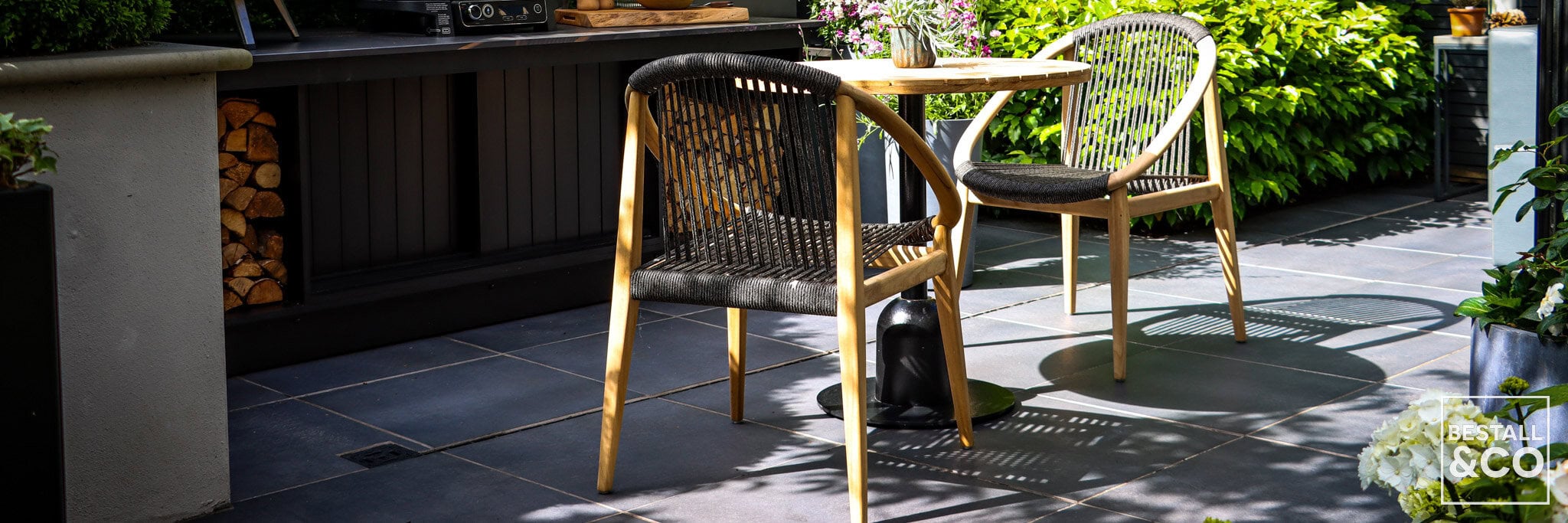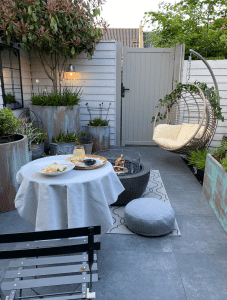10 Essential things you need to know before laying porcelain paving
You’ve heard the hype, but what is the truth and problems with porcelain paving? Lee Bestall gives you his personal opinion after trialing it at home.

1. Paving Choices
In addition to porcelain, there’s quite a few surfacing choices ranging from sandstone, granite, marble, limestone and concrete paving, decking, setts and gravel. All have different levels of durability and aftercare requirements, but does porcelain offer the perfect solution trouble free paving?
Many people are keen to voice their experience of York and Indian/imported sandstone that can discolour quickly, absorb moisture, turn green and in turn become very slippery, but before you discount them as options for you, read this article on ‘which paving is best for me?‘
2. Once you’ve decided that porcelain is for you, what’s the truth and problems?
I’ve had a light ivory coloured porcelain patio for around 4 years now (it flows from inside the house). Last year, I installed an area of dark grey tiles in a different part of the garden so here are my thoughts on both.
Using porcelain is definitely a great design choice. However, it’s not right for every property due to the ‘clean cut’ contemporary aesthetic. If you’re after the ‘I’m on holiday somewhere warm’ look, it’s perfect. I think it works really well in small modern courtyards, large terraces, around swimming pools and on roof gardens (using specially designed self adjustable plastic risers).
How easy is it to look after?
Like any internal or external surface, there’s always aftercare to be done. I like to refer to it as outdoor housework, it seems to set the expectation that way. You wouldn’t expect your car to stay clean for long if you left it out on the driveway, and you’d probably clean the floors inside your house at least once per week. External floor space is much the same. In fact, for a ‘chic hotel look’ you’ll need to sweep it every day to remove leaves & dust, blossom and general debris that blow around.
With the exception of surface debris such as leaves, porcelain tiles definitely stay cleaner for longer. It’s not as absorbent as other surfaces like sandstone, it doesn’t tend to green as quickly as sandstone. In fact, I generally only power wash the porcelain twice per year, once in March after the winter and once again in autumn once the leaves have fallen. During the lockdown year I’ll admit that I power washed every 3 months as we were using the garden more frequently, and I had more time.
3. Problems with porcelain paving

My porcelain tiles do still get dirty, in particular the lighter coloured ones. Personally I wouldn’t recommend light cream ones for the UK. Mine are constantly discoloured by tannins from leaves, stained by berries and even petals. Even when I’ve cleaned the cream tiles, they are dirty again a week later if the weather is windy or particularly wet. I would, however, highly recommend a mid or dark grey (with a slight speckle) because (with the exception of bird poo, rust stains and leaf tannins), they need much less aftercare.
Some of the problems with porcelain tiles I’ve read about include tiles lifting or becoming loose, but this is generally because they were not laid on a full bed of mortar and/or slurry primed with a proprietary primer such as UltraScape ProPrime Slurry (extreme care should be taken not to get this on the face of the tile during application). When applied to the rear of the tile prior to laying, this provides fantastic adhesion to the mortar bed, so make sure you fully research an experienced installer and get advice from the seller when you buy the tiles, as incorrect laying will probably affect any guarantee the tile suppliers offer.
Porcelain tiles shouldn’t crack if they are laid on a full bed of mortar. I’ve had them laid for 4 years now and they’ve taken temperatures down to -6C and been under snow and ice for long periods, showing no signs of movement.
I pointed my cream coloured tiles with ‘Jasmine’ Mappi exterior tile grout, but there others on the market such as the one I’ve recently used on my dark grey paving: Flowpoint Fine: Rapid Set Flowable Grout.
4. Will my porcelain paving be slippery when wet?
In my experience, I’ve honestly never noticed. Honestly, that’s the truth. I’ve walked on ours daily, through extreme frosts, ice, snow and rain and not once have I felt unsafe, but I wonder if there’s some psychology going on here. Maybe because I expect them to be more slippery than the normal paving I’m more mindful when walking on them, let’s face it, if there’s frozen ice on the paving, whichever type it is, it’s going to be slippery!
If you read the manufacturers brochure, it will give you details about the slip rating (the higher the slip rating, the less likely you are to slip). When using porcelain outside, check the slip rating is at least R11 and always use 20mm thick (10mm matching tiles for indoor areas are often available for the ‘inside-outside’ look, but are not suitable for external use on the floor – they are however great for cladding walls etc).
5. Should I select a smooth or textured surface?
I’d definitely avoid a textured surface if you’re a neat freak like me. Tiny bits of dirt and dust get trapped in the ‘pits’ and the tile can look very dirty very quickly (see picture above). The grey ones I installed have a smoother finish and I use a traditional mop & bucket approach to clean them (its less noisy than the power washer and much less hassle). I’ve started to mop the grey tiles in the courtyard weekly, because we’re using the space a lot more than we did pre covid19, and that’s the look I’m after (we have an outdoor rug and fire pit in this area so I will often sit on a cushion on the floor).
6. What colour grout should I choose?
Basically there are a couple of options, go the same as the paving eg. grey/black for darker tiles or lighter as a contrast. Personally I’d go dark grey for grey or black tiles and either cream for lighter tiles (this will make the patio look larger) or a grey which will show more of the pattern. You’d think that cream grout would get filthy outside, and as you can see from the picture it does, but it cleans up pretty well. Given a choice though, I’d go dark paving and dark (but slightly lighter or darker than the paving) external grout. I love Flowpoint Fine for this and have just used this product at home.
7. What laying pattern should I choose?
Often you’ll find the most cost effective option is to select 600mm x 600mm tiles (they are generally cheaper than large format tiles as they dry quicker during the manufacturing process) and I like to specify a half bond pattern. The half bond pattern is more forgiving if the tiles are not absolutely the same size (it often happens with cheaper tiles!).
If budget allows, select larger format tiles and even planks that can also be laid half bond (sometimes called brick bond), or 1/3 (ie divide the length of the tile between 3 and stagger the joints this way) or why not try herringbone, but be warned this this is much harder to lay and there will be increased cuts and wastage so it’s not very environmentally friendly either.
Generally 4mm spacers are used between the tiles externally, but if you’re trying to do the ‘inside-outside’ thing and align the tiles with those inside the house, be sure to use 4mm spacers internally too.
8. Should I seal the tiles?
Sealing the tiles will make them so much easier to clean. Don’t be fooled into thinking that they won’t get dirty just because they are sealed … they will! Expect to add a cost of around a pound per square metre for sealing if you’re doing it yourself using a product such as Tile Protector.
9. Is it safe to clean my tiles with household bleach?
I’ve used a mild diluted bleach solution in the past on my lighter tiles (I figured they’d get bleached in a bathroom) and if you regularly clean i’d suggest using a using a cleaner specifically designed for the job, but, if you let them get really dirty and you need a more intensive cleaner, there are products available for that too.
10. Can I use ceramic tiles outside?
I wouldn’t recommend it, not in the UK. Stick to 20mm thick porcelain tiles. If you’re looking for tiles to add some detail, try the ever increasing range of patterned porcelain tiles.
So that’s it, the truth and problems with porcelain paving… well, my personal experience of the truth anyway!
Please note that all of the products I’ve mentioned in the article have been trialed by myself independently and I have not received any free or discounted incentives. They are all genuine recommendations based on my own experience. When using products, always follow the manufacturer’s instructions.
Page updated July 2024

